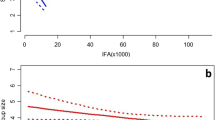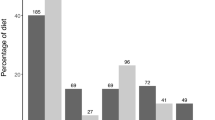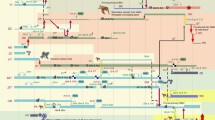Abstract
Fission–fusion social systems, in which members of a social community form frequently changing subgroups, occur in a number of mammalian taxa. Such systems are assumed to be a response to the costs of grouping, but evidence to support this hypothesis is limited. We use a linear programming approach to build a time budget model that predicts the upper bound on group size in order to test the hypothesis that fission–fusion social systems are the outcome of time constraints. Comparative data from 14 wild chimpanzee (Pan spp.) populations are used to derive a set of equations defining the relationship between climatic variables and time budget components, which are then used to calculate the upper limits on group size that can be maintained in different habitats. We validate the model by showing that it correctly predicts the presence/absence of chimpanzees across sub-Saharan Africa and the group sizes observed in natural populations. The model suggests that the costs of travel are limiting for chimpanzees. Chimpanzees can reduce these costs dramatically by fissioning their bonded communities into small foraging parties. If they did not, they would be unable to live in any habitats where they currently occur.







Similar content being viewed by others

References
Alexander RD (1974) The evolution of social behavior. Annu Rev Ecol Syst 5:325–383
Altmann J (1980) Baboon mothers and infants. Harvard University Press, Princeton
Anderson DP, Nordheim EV, Boesch C et al (2002) Factors influencing fission–fusion grouping in chimpanzees in the Tai National Park, Côte d’Ivoire. In: Boesch C, Hohmann G, Marchant L (eds) Behavioral diversity in chimpanzees and bonobos. Cambridge University Press, Cambridge, pp 90–101
Boesch C (1991) The effects of leopard predation on grouping patterns in forest chimpanzees. Behaviour 117:221–242
Boesch C (1996) Social grouping in Taï chimpanzees. In: McGrew WC (ed) Great ape societies. Cambridge University Press, Cambridge, pp 101–113
Boesch C, Boesch-Achermann H (2000) The chimpanzees of the Taï forest: behavioural ecology and evolution. Oxford University Press, Oxford
Butynski TM (2001) Africas great apes. In: Beck B, Stoinski TS, Hutchins M, Maple TL, Norton B, Rowan A, Stevens EF, Arluke A (eds) Great apes and humans; ethics of coexistence. Smithonian Institution Press, Washington, pp 3–56
Caldecott J, Miles L (eds) (2005) World atlas of great apes and their conservation. Prepared at the UNEP World Conservation Monitoring Centre. University of California Press, Berkeley, USA
Caraco T (1979) Time budgeting and group size – theory. Ecology 60:611–617
Chapman CA, White FJ, Wrangham RW (1994) Party size in chimpanzees and bonobos. In: Wrangham RW, McGrew WC, de Waal FDM, Heltne PG (eds) Chimpanzee cultures. Harvard University Press, Cambridge, MA
Chapman CA, Wrangham RW, Chapman LJ (1995) Ecological constraints on group-size – an analysis of spider monkey and chimpanzee subgroups. Behav Ecol Sociobiol 36:59–70
DeFries R, Hansen M, Townshend JRG et al (2000) Continuous fields 1 km tree cover. The Global Land Cover Facility, College Park, Maryland
Doran D (1997) Influence of seasonality on activity patterns, feeding behavior, ranging, and grouping patterns in Tai chimpanzees. Int J Primatol 18:183–206
Dunbar RIM (1991) Functional significance of social grooming in primates. Folia Primatol 57:121–131
Dunbar RIM (1992a) Behavioral ecology of the extinct papionines. J Hum Evol 22:407–421
Dunbar RIM (1992b) A model of the gelada socioecological system. Primates 33:69–83
Dunbar RIM (1992c) Time: a hidden constraint on the behavioural ecology of baboons. Behav Ecol Sociobiol 31:35–49
Dunbar RIM (1996) Determinants of group size in primates: a general model. Proc Br Acad 88:33–57
Dunbar RIM, Dunbar P (1988) Maternal time budgets of gelada baboons. Anim Behav 36:970–980
Dunbar RIM, Sharman M (1984) Is social grooming altruistic? Z Tierpsychol 64:163–173
Eggert MKH (1992) The central African rain forest – historical speculation and archaeological facts. World Archaeol 24:1–24
Eriksson J, Hohmann G, Boesch C et al (2004) Rivers influence the population genetic structure of bonobos (Pan paniscus). Mol Ecol 13:3425–3435
Fawcett KA (2000) Female relationships and food availability in a forest community of chimpanzees. Dissertation, University of Edinburgh
Ghiglieri MP (1984) Feeding ecology and sociality of chimpanzees in Kibale Forest, Uganda. In: Rodman PS, Cant JGH (eds) Adaptations for foraging in nonhuman primates. Columbian University Press, New York, pp 161–194
Goodall J (1968) The behaviour of free-living chimpanzees in the Gombe Stream area. Anim Behav Monogr 1:161–311
Goodall J (1983) Population dynamics during a 15 year period in one community of free-living chimpanzees in the Gombe-National-Park, Tanzania. Z Tierpsychol 61:1–60
Goodall J (1986) The chimpanzees of Gombe: patterns of behavior. The Belknap Press of Harvard University Press, Cambridge
Greengrass E (2000) The sudden decline of a community of chimpanzees in Gombe National Park. Pan Afr News 7. http://mahale.web.infoseek.co.jp/PAN/7_1/7(1)-0.5.html
Hashimoto C, Furuichi T, Tashiro Y (2001) What factors affect the size of chimpanzee parties in the Kalinzu Forest, Uganda? Examination of fruit abundance and number of estrous females. Int J Primatol 22:947–959
Hashimoto C, Suzuki S, Takenoshita Y et al (2003) How fruit abundance affects the chimpanzee party size: a comparison between four study sites. Primates 44:77–81
Hill RA, Dunbar RIM (2002) Climatic determinants of diet and foraging behaviour in baboons. Evol Ecol 16:579–593
Hunt KD, McGrew WC (2002) Chimpanzees in the dry habitats of Assirik, Senegal and Semliki Wildlife Reserve, Uganda. In: Boesch C, Hohmann G, Marchant L (eds) Behavioural diversity in chimpanzees and bonobos. Cambridge University Press, Cambridge, pp 35–51
Itani J, Suzuki A (1967) The social unit of chimpanzees. Primates 8:355–381
Jones C, Sabater Pi J (1971) Comparative ecology of Gorilla gorilla (Savage and Wyman) and Pan troglodytes (Blumenbach) in Rio Muni, West Africa. S. Karger, Basel
Kano T, Mulavwa M (1984) Feeding ecology of the pygmy chimpanzees (Pan paniscus) of Wamba. In: Susman RL (ed) The pygmy chimpanzee. Plenum, New York, pp 233–274
Klein LL, Klein DB (1977) Feeding behaviour of the Colombian spider monkey. In: Clutton-Brock TH (ed) Primate ecology: studies of feeding and ranging behaviour in lemurs, monkeys and apes. Academic, London, pp 153–181
Kormos R, Boesch C, Bakarr MI et al (2003) West African chimpanzees. Status survey and conservation action plan. IUCN, Gland, Switzerland and Cambridge
Korstjens AH, Dunbar RIM (2007) Time constraints limit group sizes and distribution in red and black-and-white colobus monkeys. Int J Primatol (in press)
Korstjens AH, Verhoeckx IL, Dunbar RIM (2006) Time as a constraint on group size in spider monkeys. Behav Ecol Sociobiol. DOI 10.1007/s00265-006-0212-2
Kummer H (1971) Primate societies: group techniques of ecological adaptation. Aldine-Atherton, Chicago
Le Houérou HN (1984) Rain use efficiency – a unifying concept in arid land ecology. J Arid Environ 7:213–247
Legates DR, Willmott CJ (1990a) Mean seasonal and spatial variability in gauge-corrected, global precipitation. Int J Climatol 10:111–127
Legates DR, Willmott CJ (1990b) Mean seasonal and spatial variability in global surface air-temperature. Theor Appl Climatol 41:11–21
Lehmann J, Boesch C (2003) Social influences on ranging patterns among chimpanzees (Pan troglodytes verus) in the Taï National Park, Côte d’Ivoire. Behav Ecol 14:642–649
Lehmann J, Boesch C (2004) To fission or to fusion: effects of community size on wild chimpanzee (Pan troglodytes verus) social organisation. Behav Ecol Sociobiol 56:207–216
Lehman J, Korstjens AH, Dunbar RIM (in press) Group size, grooming and social cohesion in primates. Anim Behav
Matsumoto-Oda A (2002) Behavioral seasonality in Mahale chimpanzees. Primates 43:103–117
Matsumoto-Oda A, Hosaka K, Huffman MA et al (1998) Factors affecting party size in chimpanzees of the Mahale Mountains. Int J Primatol 19:999–1011
McBrearty S, Jablonski NG (2005) First fossil chimpanzee. Nature 437:105–108
McGrew WC, Baldwin PJ, Tutin CEG (1988) Diet of wild chimpanzees (Pan troglodytes verus) at Mt. Assirik, Senegal: I. Composition. Am J Primat 16:213–226
Mitani JC, Watts DP, Lwanga JS (2002a) Ecological and social correlates of chimpanzee party size and composition. In: Boesch C, Hohmann G, Marchant L (eds) Behavioural diversity in chimpanzees and bonobos. Cambridge University Press, Cambridge, pp 102–111
Mitani JC, Watts DP, Pepper JW et al (2002b) Demographic and social constraints on male chimpanzee behaviour. Anim Behav 64:727–737
Myer-Thompson JA (2002) Bonobos at the Lukuru Wildlife Research Project. In: Boesch C, Hohmann G, Marchant L (eds) Behavioural diversity in chimpanzees and bonobos. Cambridge University Press, Cambridge, pp 61–70
Myer-Thompson JA (2003) A model of the bio-geographical journey from Proto-Pan to Pan Paniscus. Primates 44:191–197
Newton-Fisher NE (1999a) Association by male chimpanzees: a social tactic? Behaviour 136:705–730
Newton-Fisher NE (1999b) The diet of chimpanzees in the Budongo Forest Reserve, Uganda. Afr J Ecol 37:344–354
Newton-Fisher NE, Reynolds V, Plumptre AJ (2000) Food supply and chimpanzee (Pan troglodytes schweinfurthii) party size in the Budongo Forest Reserve, Uganda. Int J Primatol 21:613–628
Nishida T (1968) The social group of wild chimpanzees in the Mahali mountains. Primates 9:167–224
Nishida T (1990) The chimpanzees of the Mahale mountains. University of Tokyo Press, Tokyo
Nishida T, Uehara S (1983) Natural diet of chimpanzees (Pan troglodytes schweinsfurthii): long-term record from the Mahale Mountains, Tanzania. Afr Study Monogr 3:109–130
Nishida T, Corp N, Hamai M et al (2003) Demography, female life history, and reproductive profiles among the chimpanzees of Mahale. Am J Primatol 59:99–121
Owens MJ, Owens DD (1978) Feeding ecology and its influence on social organization in brown hyenas (Hyena brunnea, Thunberg) of the central Kalahari desert. East Afr Wildl J 16:113–135
Reynolds V, Reynolds F (1965) Chimpanzees of the Budongo Forest. Holt, Rinehart and Winston, New York
Rodseth L, Wrangham RW, Harrigan AM et al (1991) The human community as a primate society. Curr Anthropol 32:221–254
Sakura O (1994) Factors affecting party size and composition of chimpanzees (Pan troglodytes verus) at Bossou, Guinea. Int J Primatol 15:167–183
Smolker RA, Richards AF, Connor RC et al (1992) Sex-differences in patterns of association among Indian Ocean bottle-nosed dolphins. Behaviour 123:38–69
Sugiyama Y, Koman J (1987) A preliminary list of chimpanzee alimentation at Bossou, Guinea. Primates 28:133–147
Takemoto H (2004) Seasonal change in terrestriality of chimpanzees in relation to microclimate in the tropical forest. Am J Phys Anthropol 124:81–92
Thompson JAM (1997) The history, taxonomy and ecology of the Pan paniscus (Pan paniscus, Schwarz, 1992) with a first description of a wild population living in a forest/savanna mosaic habitat. Dissertation, University of Oxford
Tutin CEG, Fernandez M (1993) Composition of the diet of chimpanzees and comparisons with that of sympatric lowland gorillas in the Lope Reserve, Gabon. Am J Primatol 30:195–211
Tutin CEG, McGrew WC, Baldwin PJ (1983) Social organization of savanna-dwelling chimpanzees, Pan troglodytes verus, at Mt. Assirik, Senegal. Primates 24:154–173
Tutin CEG, Ham RM, White LJT et al (1997) The primate community of the Lope Reserve, Gabon: diets, responses to fruit scarcity, and effects on biomass. Am J Primatol 42:1–24
Tweheyo M, Lye KA, Weladji RB (2004) Chimpanzee diet and habitat selection in the Budongo Forest Reserve, Uganda. For Ecol Manag 188:267–278
Van Schaik CP, Van Hooff J (1983) On the ultimate causes of primate social-systems. Behaviour 85:91–117
Watts DP (2000) Grooming between male chimpanzees at Ngogo, Kibale National Park. I. Partner number and diversity and grooming reciprocity. Int J Primatol 21:189–210
White FJ (1992) Activity budgets, feeding behavior, and habitat use of pygmy chimpanzees at Lomako, Zaire. Am J Primatol 26:215–223
White FJ (1996) Comparative socio-ecology of Pan paniscus. In: McGrew WC, Marchant L, Nichida T (eds) Great ape societies. Cambridge University Press, Cambridge, pp 29–44
Williams JM, Oehlert GW, Carlis JV, Pusey AE (2004) Why do male chimpanzees defend a group range? Anim Behav 68:523–532
Williamson D, Dunbar RIM (1999) Energetics, time budgets and group size. In: Lee PC (ed) Comparative primate socioecology. Cambridge University Press, Cambridge
Willmott CJ, Matsuura K (2001) Terrestrial air temperature and precipitation: monthly and annual climatologies (version 3.02). http://climategeogudeledu/∼climate/
Wittig RM, Boesch C (2003) Food competition and linear dominance hierarchy among female chimpanzees of the Tai National Park. Int J Primatol 24:847–867
Wrangham RW (1974) Artificial feeding of chimpanzees and baboon in their natural habitat. Anim Behav 22:83–93
Wrangham RW (1975) The behavioral ecology of chimpanzees in Gombe National Park, Tanzania. Dissertation, Cambridge University
Wrangham RW (1977) Feeding behaviour of chimpanzees in Gombe National Park, Tanzania. In: Clutton-Brock TH (ed) Primate ecology. Academic, London, pp 503–538
Wrangham RW (1986a) Ecology and social relationships in two species of chimpanzees. In: Rubenstein DI, Wrangham RW (eds) Ecology and social evolution: birds and mammals. Princeton University Press, Princeton, pp 352–378
Wrangham RW (1986b) Social relationships in chimpanzees. In: Rubenstein DI, Wrangham RW (eds) Ecological aspects of social evolution: birds and mammals. Princeton University Press, Princeton, pp 352–378
Wrangham RW (2000) Why are male chimpanzees more gregarious than mothers? A scramble competition hypothesis. In: Kappeler P (ed) Primate males. Cambridge University Press, Cambridge
Wrangham RW, Smuts BB (1980) Sex differences in the behavioural ecology of chimpanzees in the Gombe National Park, Tanzania. J Reprod Fertil Suppl 28:13–31
Wrangham RW, Clark AP, Isabirye-Basuta G (1992) Female social relationships and social organisation of the Kibale Forest chimpanzees. In: Nishida T, McGrew WC, Marler P, Pickford M, de Waal FDM (eds) Topics in primatology. Human origins, vol 1. University of Tokyo Press, Tokyo, pp 81–98
Yamagiwa J, Maruhashi T, Yumoto T et al (1996) Dietary and ranging overlap in sympatric gorillas and chimpanzees in Kahuzi-Biega National Park, Zaire. Cambridge University Press, Cambridge
Yamakoshi G (1998) Dietary responses to fruit scarcity of wild chimpanzees in Bossou, Guinea: possible implications for ecological importance of tool use. Am J Phys Anthropol 106:283–295
Yamakoshi G (2004) Food seasonality and socio-ecology in Pan: are West African chimpanzees another bonobo? Afr Study Monogr 25:45–60
Acknowledgements
JL is funded by the British Academy Centenary Research Project and AHK by a project grant from the Leverhulme Trust. RIMD is supported by a British Academy Research Professorship. We would also like to thank colleagues who provided us with further details on chimpanzee time budget data, Hjalmar Kuehl for his help with forest cover data and Guy Cowlishaw for helpful comments on the manuscript. The in-depth analysis we did would not have been possible without the generosity of Cort Willmott and Kenji Matsuura from the University of Delaware. We also thank Stephen Blake and Nigel Hunter (ICNN) for the bonobo dataset at DRC, and Noelle Kumpel, Imperial College London/Zoological Society of London, for some unpublished data on chimpanzees in Equatorial Guinea.
Author information
Authors and Affiliations
Corresponding author
Rights and permissions
About this article
Cite this article
Lehmann, J., Korstjens, A.H. & Dunbar, R.I.M. Fission–fusion social systems as a strategy for coping with ecological constraints: a primate case. Evol Ecol 21, 613–634 (2007). https://doi.org/10.1007/s10682-006-9141-9
Received:
Accepted:
Published:
Issue Date:
DOI: https://doi.org/10.1007/s10682-006-9141-9



